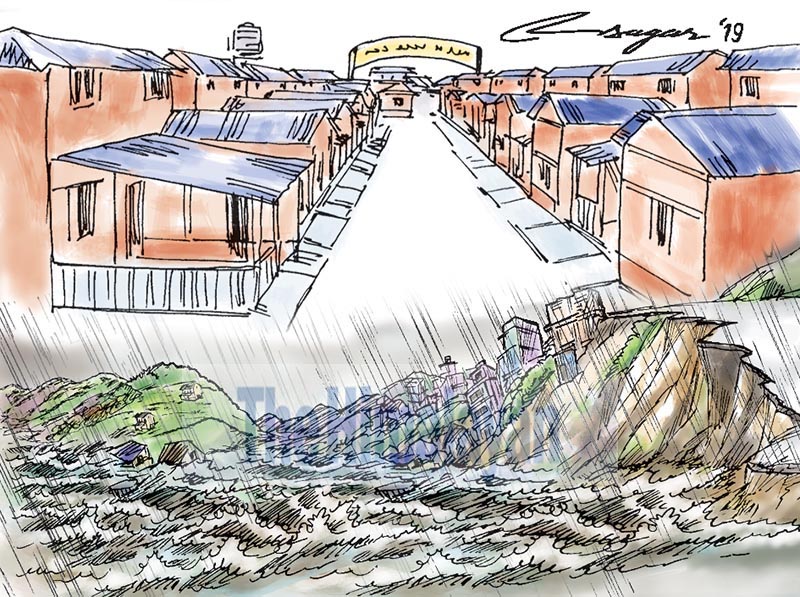Mitigating multi-hazards: Futurism is going local
As the hazards are very much local, incorporation of multi-hazard concepts in the design of structures is a means to leapfrogging towards multi-hazard-resilient communities
Following the storm Parvana in Bara and Parsa on March 31, the impacts of multiple natural hazards acting on structures and infrastructure are being more pronounced. So was the case immediately after the Gorkha Earthquake of 2015 and the central Nepal floods of 2017. The Khimti flash flood following the 2015 Gorkha Earthquake had swept away bridges apart from causing damage to buildings. However, engineers, policymakers and practitioners are used to dealing with individual hazards and their impacts only.
From climate change to haphazard infrastructure development, natural hazards nowadays are taking place in a sequence, giving rise to a multi-hazard scenario. Either single or cascading hazards could affect the human population and the country at large. Being a developing country, immediate rebuilding of structures and infrastructure caused by one natural hazard is not possible. This, in turn, could lead to more damage.
For instance, the houses affected by the March 31 storm Parvana in Bara and Parsa, are very likely to be affected by the floods this monsoon. Structures and infrastructure both play a vital role in assuring quality of life. But they could stay non-functional due the single or multiple hazards. Engineers and practitioners have not sought to incorporate multiple-hazard scenarios in their design and construction. This may lead to more vulnerable structures and infrastructure in Nepal.
The United Nations Development Programme had noted that Nepal was the 20th most multi-hazard vulnerable country back in 2004. As the hazards are very much local, though they may have broader impacts, incorporation of multi-hazard concepts in the design of structures is a means to leapfrogging towards multi-hazard-resilient communities. The Nepal Building Code should be the first to endorse the concept of multi-hazard resilience.
Resilience against a single hazard can never be holistic at least for Nepal. The country is a hotspot for moderate to strong earthquakes, annual flash floods, slope instability and landslides, heat waves, cold waves and fires. To this end, the steps taken by Nepal Engineer’s Association would be pragmatic.
The effort comprises development of a multi-hazard, resilient, low-cost rural housing system for the storm Parvana victims. The model captures the scenario of an earthquake, flood, fire, heat wave, cold wave and storm effects to encapsulate the multi-hazard-resilient features. People living below the poverty line undoubtedly seek government support after every disaster, but the resources are limited.
To cope with the situation, multi-hazard, resilient, low-cost housing is the future. Constructed mostly with local, easily available, replaceable, low maintenance-demanding vernacular materials, the low-cost, though galvanised, housing models will certainly address the growing housing demand as well as the government’s promise of safe housing to all.
The government together with the local levels could assess the possibilities of vernacular construction materials in all the regions of Nepal and ultimately could also endorse some low-cost, multi-hazard, resilient structural forms, which could be directly replicated in-situ. The biggest little challenge right now is that people are very attracted to modern materials, and this is imposing huge economic pressure on the poor people. They are obliged to go for such construction just to get approval of the drawings from the authorities.
To mend this system, the government could itself define some models and provide subsidies to the disaster victims as well as the people in dire need of economic support to construct buildings.
The recently proposed model by us mostly utilise the local materials, including folded bamboo and locally available clay and requires least modern materials to downscale the overall cost of construction. Stating that only reinforced concrete buildings are resilient is premature and fallacious. Neither is the hurried decision to implement the prototype buildings designed for the People’s Housing Project sagacious as native buildings in the southern plains demand several other factors to cope not only with earthquakes but also floods, storms, heat wave, cold wave and fires.
Resilient communities are sustainable communities, so endorsement of modified vernacularism may downscale the overall cost of construction in Nepal, which is the need of our time. In addition, prediction of multi-hazards, counteracting mechanisms, experimental and numerical analysis-based prototypes, among others, have surfaced as challenges among the engineers. So, rigorous research to outline the exact hazard scenario should be a priority of the government as well as academic sector. Thereafter, resilience assessment could be conducted to develop prototypes by endorsing vernacular materials.
A bit of appreciation of the existing construction system should be synchronised to protect the flavour as well as indigenous knowledge. As multi-hazards become more common, the time to revisit the standards is now or never. Present practices in Nepal are not necessarily in line with the hazard scenarios, so periodic updates are needed and newly-emerging knowledge should also get its placement in the dynamics of resilient and sustainable housing construction.






